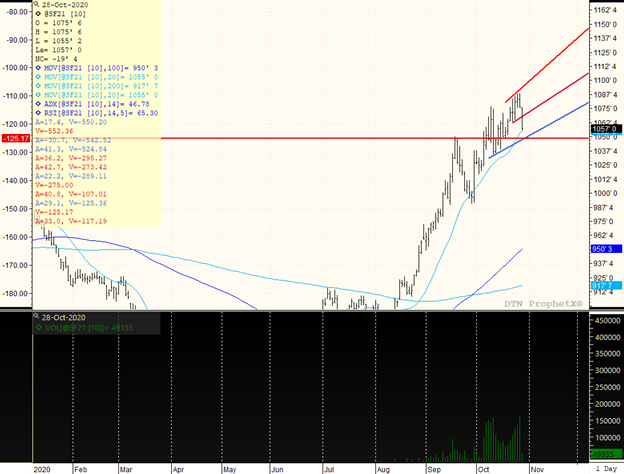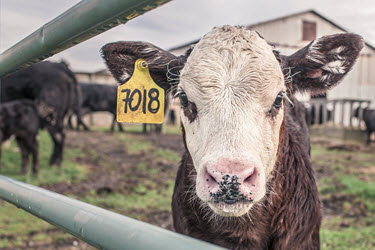GOOD MORNING,
Weaker macro markets, overbought conditions, and too long funds are resulting in lower markets across the board, and perhaps one of the best turns from the top that we have seen since the rally started. Losses this AM are significant enough to suggest that potential tops are in place.
Price action started to break down shortly after 1:00 in the morning to current AM lows. A "calmer heads prevail" attitude traversed the grain and soy complex yesterday, with a net of new contract highs followed by a low volume weaker close. For beans, tensions between China and the US, better weather in SA, and what seems to be a bit of space in the pace of Chinese buying activity prompts profit-taking behavior. The last report of confirmed Chinese purchases was nearly two weeks ago, and there were no sales announcements Monday. Still, corn and bean basis continues to narrow as the crop is harvested and put away. Prices will continue to rally sufficiently enough to make sure all export sales on the books are managed.
In terms of technicals, a few reversal patterns are starting to show in the form of possible bear flags and descending triangles, which are all suggestive that prices could have reached some temporary tops. A more detailed explanation is offered in the tech talk portion.
WEATHER
--US weather will turn drier and warmer this week but rains this week have slowed harvest. Zeta is re-strengthening early Wed into a hurricane bearing down on Louisiana. Hurricane warning stretches from Louisiana to the Alabama State Line.
--Rains continue to stabilize crops in SA adding to bearish bean sentiment.
ANNOUNCEMENTS
Brazil's ANEC forecast Oct. 2020 bean exports at 2.38 mmt vs. 2.32 mmt week ago. October 2020 corn exports were forecast at 4.95 mmt, vs. 5.5 mmt week ago. Brazil's corn prices surpassed a 2007 record, reaching 81.48 reais, ($14.49), per sack, according to the benchmark index of the Brazilian agricultural think tank Cepea.
Brazil's second major bean producing state of Parana reached 61% planted for the 20/21 bean season, up 29% from the prev. week, but compared to 65% year ago, according to Brazil's Deral. Parana's wheat crops were 82% good conditions, with harvest at 90% complete, ahead of 87% year ago.
CALLS
Calls are as follows:
beans: 18-20 lower
meal: $10.00-$12.00 lower
soyoil: 70-80 lower
corn: 8-10 lower
wheat: 11-13 lower
OUTSIDE MARKETS
Weaker with crude oil trading down to $37.62/barrel, and the US dollar back to 93.51. Stocks are 470 pts lower on rising covid cases which could mean further lockdowns and slowing demand. There are morning reports that Germany and France could go into nationwide lockdowns as soon as this week.. The lack of stimulus until after the elections appears to be a reality, also hurting the stock market.
TECH TALK
- December wheat now puts a top in place with a line of resistance crossing from $6.36-$6.40, and new lows which take out the 20 day average at $6.06. This turn lower from higher and the move through $6.06 increases the chance for follow-through and a move to multiple lows of $5.90 at the bottom, with interim support at $5.96. If short, due to recent strength, may also want to scale down cover from $5.98/$6.02 first, and save the rest in case prices take out $6.00.
- December corn places a new high for the move up at $2.22 1/4 but forms a bear flag at the top which foreshadows that a reversal trade is about to occur. The pullback to $4.05 does not change the trend, but the small gap lower price action suggests that more follow-through could occur, with the 20-day moving average at $3.99. If prices go there, would look to increase pricing ideas, as $4.00 has held good support since September.
- January beans break double lows at $10.63 to trigger sell-stops with $10.55 as a current morning low, which sits on the day 20 day moving average. Would look for downside follow-through, and $10.48 to $10.52 should cushion a further loss. The break is attempting to define a trading range low, but the market has not yet reversed trend. The break in beans also alleviates current overbought conditions.
- December meal turns lower from contract highs of $392.70, which matched a May 2018 high. The ADX still remains strong for this market at 60, but could begin to weaken should prices take out current lows of $370.00. A turn of trend and further losses would come from any break of $360.00.
- December soyoil prices remain sideways from 32c-35c, posting double highs on the recent rally at 3470c, with a turn lower from higher. Best support is close at 3320c, but under that level would be prepared to move to 3270c, which is strong trendline support.
JANUARY BEANS
While the top has now been placed with a contract high of $10.88 1/2, the market reverses course and trades lower from higher, leaving what could be construed as a bear flag at the top of the market as outlined in red. The mission of the market is now to find a value trading range from the overall high. Would look for any drop under $10.62 to add another bearish element which could trigger profit-taking and a further move to $10.50. The ADX trend is still strong at 48, meaning setbacks to major areas of support should find pricing, short-covering, or out-right bottom picking. The trend in this market still remains strong, and trendline support for the day crosses at $10.48/$10.52. If we go there, would elect to cover in a partial short, as a reversal of trend is not yet clear.

TAGS – Feed Grains, Soy & Oilseeds, Wheat, North America



 Corn, soybeans and soyoil all closed lower after trading up the previous three sessions. July soymeal made it a fourth trading session higher, and wheat remains on a tear with a fifth trading session closing higher. The mood around wheat sees supply concerns developing in North America and in t...
Corn, soybeans and soyoil all closed lower after trading up the previous three sessions. July soymeal made it a fourth trading session higher, and wheat remains on a tear with a fifth trading session closing higher. The mood around wheat sees supply concerns developing in North America and in t...
 Cow-calf producer margins are discussed less frequently in these pages than their downstream counterparts of feedlot and beef packer margins, but this doesn’t mean they are less important to understanding the beef industry’s current state and outlook. Additionally, discussion of thi...
Cow-calf producer margins are discussed less frequently in these pages than their downstream counterparts of feedlot and beef packer margins, but this doesn’t mean they are less important to understanding the beef industry’s current state and outlook. Additionally, discussion of thi...
 Reigniting a Transatlantic Deal Former Italian prime minister Enrico Letta is something of a policy rock star after authoring a report on the future strategy for the EU. Most of the 146-page report focuses on strengthening the EU’s internal Single Market but, buried at the end of th...
Reigniting a Transatlantic Deal Former Italian prime minister Enrico Letta is something of a policy rock star after authoring a report on the future strategy for the EU. Most of the 146-page report focuses on strengthening the EU’s internal Single Market but, buried at the end of th...